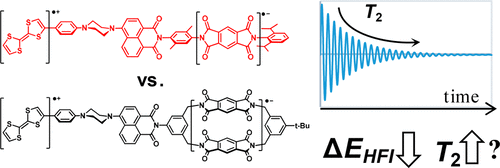当前位置:
X-MOL 学术
›
J. Phys. Chem. A
›
论文详情
Our official English website, www.x-mol.net, welcomes your feedback! (Note: you will need to create a separate account there.)
Effect of Electron–Nuclear Hyperfine Interactions on Multiple-Quantum Coherences in Photogenerated Covalent Radical (Qubit) Pairs
The Journal of Physical Chemistry A ( IF 2.9 ) Pub Date : 2018-11-15 00:00:00 , DOI: 10.1021/acs.jpca.8b07556 Jordan N. Nelson 1 , Jinyuan Zhang 1 , Jiawang Zhou 1 , Brandon K. Rugg 1 , Matthew D. Krzyaniak 1 , Michael R. Wasielewski 1
The Journal of Physical Chemistry A ( IF 2.9 ) Pub Date : 2018-11-15 00:00:00 , DOI: 10.1021/acs.jpca.8b07556 Jordan N. Nelson 1 , Jinyuan Zhang 1 , Jiawang Zhou 1 , Brandon K. Rugg 1 , Matthew D. Krzyaniak 1 , Michael R. Wasielewski 1
Affiliation

|
Ultrafast photodriven electron transfer reactions starting from an excited singlet state in an organic donor–acceptor molecule can generate a spin-correlated radical pair (RP) with an initially entangled spin state that may prove useful as a two-qubit pair in quantum information protocols. Here we investigate the effects of modulating electron–nuclear hyperfine coupling by rapidly transferring an electron between two equivalent sites comprising the reduced acceptor of the RP. A covalent electron donor–acceptor molecule including a tetrathiafulvalene (TTF) donor, a 4-aminonaphthalene-1,8-imide (ANI) chromophoric primary acceptor, and an m-xylene bridged cyclophane having two equivalent pyromellitimides (PI2), TTF-ANI-PI2, as a secondary acceptor was synthesized along with an analogous molecule having one pyromellitimide (PI) acceptor, TTF-ANI-PI. Photoexcitation of ANI within each molecule results in sub-nanosecond formation of TTF+•-ANI-PI-• and TTF+•-ANI-PI2-•. The effect of reducing electron–nuclear hyperfine interactions in TTF+•-ANI-PI2-• relative to TTF+•-ANI-PI-• on decoherence of multiple-quantum coherences has been measured by pulse-EPR spectroscopy. This contribution is especially relevant in the absence of modulation of exchange or dipolar interactions, as with the RP at a fixed distance in the molecules in this work. The theoretical prediction of the contribution from an ensemble of hyperfine interactions to decoherence in these RPs is shown to be less than the full width at half-maximum of the quantum beat frequencies measured experimentally. Pulse bandwidth and off-resonant excitation by square microwave pulses are proposed as larger contributors to decoherence in these molecules than the hyperfine interactions, and specific pulse shapes relevant to arbitrary waveform generation are introduced.
中文翻译:

电子-核超精细相互作用对光生共价自由基(量子位)对中多量子相干性的影响
从有机供体-受体分子中的激发单重态开始的超快光驱动电子转移反应可以生成自旋相关的自由基对(RP),其初始纠缠自旋状态可能在量子信息协议中被用作两个量子位的对。在这里,我们通过在包含RP受体还原的两个等效位点之间快速转移电子来研究调节电子-核超精细耦合的效应。的共价电子供体-受体分子包括硫富瓦烯(TTF)供体,4-氨基萘-1,8-二酰亚胺(ANI)发色初级受体,和米二甲苯桥接具有两个等效pyromellitimides(PI环芳2),TTF- ANI-PI 2作为第二受体,其与具有一个均苯四甲酰亚胺(PI)受体TTF-ANI-PI的类似分子一起被合成。每个分子内ANI的光激发导致亚纳秒级的TTF +• -ANI-PI- •和TTF +• -ANI-PI 2- •的形成。相对于TTF +• -ANI-PI- •减少TTF +• -ANI-PI 2- •中电子核超精细相互作用的作用多脉冲相干的去相干性已经通过脉冲EPR光谱法进行了测量。在没有调节交换或偶极相互作用的情况下,这种作用尤其重要,就像在这项工作中分子中固定距离的RP一样。在这些RP中,超精细相互作用的集合对退相干的贡献的理论预测显示,小于实验测得的量子拍频一半时的全宽。与超精细相互作用相比,提出了由方形微波脉冲产生的脉冲带宽和失谐激发作为更大的促成退相干的因素,并介绍了与任意波形产生有关的特定脉冲形状。
更新日期:2018-11-15
中文翻译:

电子-核超精细相互作用对光生共价自由基(量子位)对中多量子相干性的影响
从有机供体-受体分子中的激发单重态开始的超快光驱动电子转移反应可以生成自旋相关的自由基对(RP),其初始纠缠自旋状态可能在量子信息协议中被用作两个量子位的对。在这里,我们通过在包含RP受体还原的两个等效位点之间快速转移电子来研究调节电子-核超精细耦合的效应。的共价电子供体-受体分子包括硫富瓦烯(TTF)供体,4-氨基萘-1,8-二酰亚胺(ANI)发色初级受体,和米二甲苯桥接具有两个等效pyromellitimides(PI环芳2),TTF- ANI-PI 2作为第二受体,其与具有一个均苯四甲酰亚胺(PI)受体TTF-ANI-PI的类似分子一起被合成。每个分子内ANI的光激发导致亚纳秒级的TTF +• -ANI-PI- •和TTF +• -ANI-PI 2- •的形成。相对于TTF +• -ANI-PI- •减少TTF +• -ANI-PI 2- •中电子核超精细相互作用的作用多脉冲相干的去相干性已经通过脉冲EPR光谱法进行了测量。在没有调节交换或偶极相互作用的情况下,这种作用尤其重要,就像在这项工作中分子中固定距离的RP一样。在这些RP中,超精细相互作用的集合对退相干的贡献的理论预测显示,小于实验测得的量子拍频一半时的全宽。与超精细相互作用相比,提出了由方形微波脉冲产生的脉冲带宽和失谐激发作为更大的促成退相干的因素,并介绍了与任意波形产生有关的特定脉冲形状。



























 京公网安备 11010802027423号
京公网安备 11010802027423号